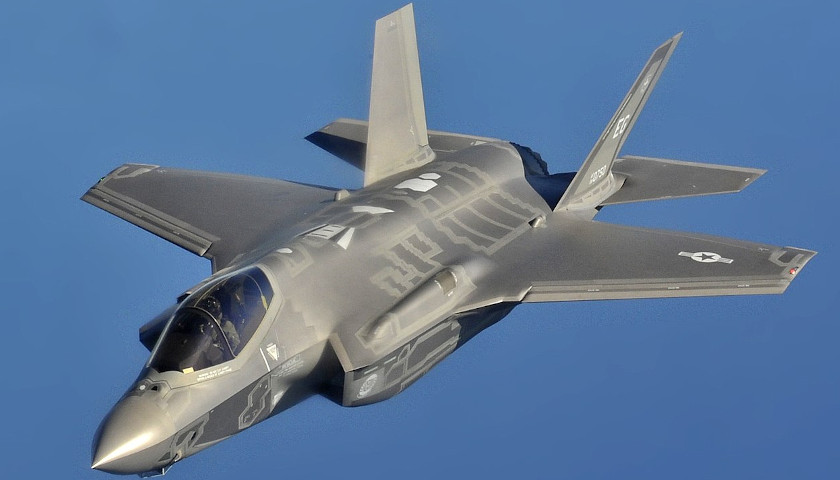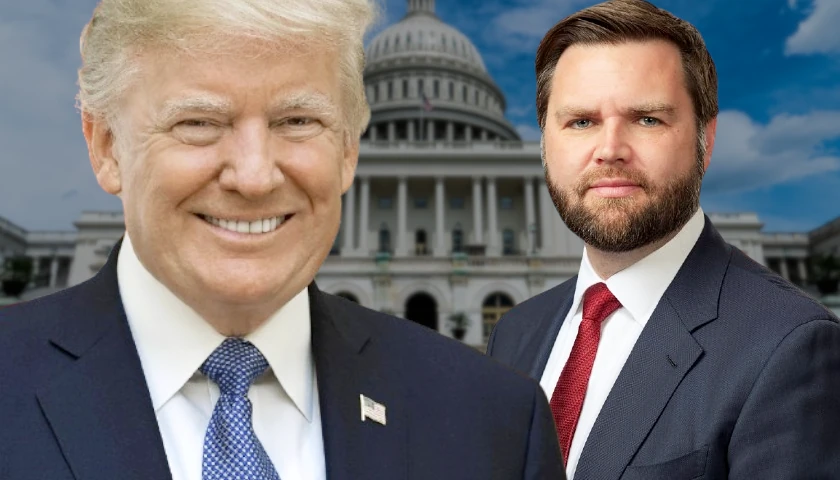by Robert Romano
The fifth-generation F-35 stealth fighter jet by Lockheed Martin has been in development since the 1990s, one of the most expensive military systems ever at a cost of about $80 million per plane, after all these years is still dependent on global supply chains including certain Chinese-made components and rare earth minerals.
From the beginning of the program the U.S., the United Kingdom, Canada, Denmark, the Netherlands, Norway, Italy, Turkey, and Australia have all participated in financing and producing the plane.
According to the Congressional Research Service, “the F-35 is manufactured in several locations. Lockheed Martin builds the aircraft’s forward section in Fort Worth, TX. Northrop Grumman builds the midsection in Palmdale, CA, and the tail is built by BAE Systems in the United Kingdom.”
After that, per CRS: “Final assembly of these components takes place in Fort Worth. Final assembly and checkout facilities have also been established in Cameri, Italy, and Nagoya, Japan.”
Over the next 60 years, the fleet of F-35s is expected to cost $1 trillion—with two-thirds of that cost in operations and sustainment.
The parts themselves come from all over, and now, deficiencies in spare parts production and sustainment for the fighter plane is costing taxpayers big-time, with maintenance of the aircraft and concerns that Lockheed Martin provided defective spare parts and an outdated technology system for the F-35. These issues were front and center in a July 22 House Oversight and Reform Committee hearing.
Adding to concerns, in 2012 and 2013 under the Obama administration, the Pentagon waived laws banning Chinese-built components on U.S. weapons systems, including rare earth magnets in order to keep the program on track.
In addition, a Chinese-owned company Exception PCB, based in Gloucestershire, UK has been manufacturing key circuit boards for the plane. The company was acquired by Shenzhen Fastprint in 2013.
In May, in a Fox Business interview with Maria Bartiromo, President Donald Trump outlined the problem: “It’s a great jet, and we make parts for this jet all over the world. We make them in Turkey, we make them here, we’re going to make them there. All because President [Barack] Obama and others — I’m not just blaming him — thought it was a wonderful thing. The problem is if we have a problem with a country, you can’t make the jet. We get parts from all over the place. It’s so crazy. We should make everything in the United States.”
When Bartiromo asked if it was feasible to make it in the U.S., President Trump said, “Yeah, we’re doing it because I’m changing all those policies.”
President Trump is right. At the time, he was blasting the fact that some of the fuselages for the plane are made in Turkey, a contract that has now been cancelled because Turkey opted to purchase Russian-made air defense systems. That part of the production is now simply moving to Norway and the Netherlands, according to CRS.
But the supply chain difficulties do not end there. The continued rare earth mineral shortage will surely come into play should the U.S. and China ever find itself in a military conflict or even just a trade war. Rare earths are used in smart phones, computers and high-tech military hardware including the F-35, but for years China has had a global monopoly on their production.
According to CRS, “each F-35 Lightning II aircraft would require approximately 920 pounds of these materials.”
The Trump administration fortunately is already addressing the shortfall.
In 2019, the Pentagon began assessing the lack of U.S. production for rare earths and began asking miners to submit plans to develop more U.S. mines and processing facilities last summer. “The overall goal is to secure and assure a viable, domestic supplier (of rare earths) for the long-term,” according the Pentagon paper sent to the miners.
On July 22, 2019, President Trump invoked the 1950 Defense Production Act on July 22 in a proclamation, writing, “the domestic production capability for Samarium Cobalt Rare Earth Permanent Magnets is essential to the national defense. Without Presidential action under section 303 of the Act, United States industry cannot reasonably be expected to provide the production capability for Samarium Cobalt Rare Earth Permanent Magnets adequately and in a timely manner.”
The proclamation added, “Further, purchases, purchase commitments, or other action pursuant to section 303 of the Act are the most cost-effective, expedient, and practical alternative method for meeting the need for this critical capability.”
By invoking the law, the Defense Department can go ahead and fund directly the construction of rare earth processing facilities in the U.S. and expand mining operations by working with private contractors.
The U.S. consumed about 13,000 metric tons of rare earths in 2019, according to the U.S. Geological Survey, and we are 100 percent reliant on imports of rare earth metals, 80 percent of which comes from China. Other imports come from Estonia at 6 percent, and 3 percent from Japan and Malaysia. 8 percent comes from other countries.
According to the U.S. Geological Survey, “The estimated value of rare-earth compounds and metals imported by the United States in 2019 was $170 million, an increase from $160 million in 2018.” But these numbers do not account for rare earths used in manufacturing in China and then exported.
Despite being in a commanding position for years, the good news is that China has been losing global market share, from 95 percent of global production in 2010 down to 63 percent of global market share now.
MP Materials, which runs the Mountain Pass site in California’s San Bernardino County, the nation’s only operational rare earth facility, has gotten back online. According to the U.S. Geologic Survey: “Rare earths were mined domestically in 2019. Bastnaesite (or bastnäsite), a rare-earth fluorocarbonate mineral, was mined as a primary product at a mine in Mountain Pass, CA, which was restarted in the first quarter of 2018 after being put on care-and-maintenance status in the fourth quarter of 2015.” 26,000 metric tons were mined, but much of it is still exported to China for processing, making it the number two producer in the world. We have about 1.4 million metric tons of reserves in the U.S.
Australia has also ramped up production the past decade and mined 21,000 metric tons in 2019. Australia also has all of the elements we would be looking for, according to Geoscience Australia. Additionally, a discovery of 16 million tons of rare earth oxides off the coast of Japan last year could supply the minerals for the entire world for centuries.
Overall, it is up to Congress to require that the F-35 and its parts and components, including the rare earths mining and processing, be insourced to the extent that is practical. President Trump is right. We shouldn’t be dependent on Chinese parts or such large global supply chains that would surely be taxed in the event of a conflict. Air power is one of the most vital components to our national security, without which we cannot win, and the U.S. should never be in a position where it could be ever be questioned, especially not due to outsourcing.
– – –
Robert Romano is the Vice President of Public Policy at Americans for Limited Government.





